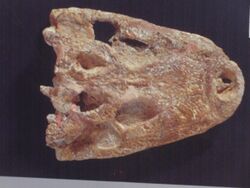Biology:Acynodon
| Acynodon | |
|---|---|

| |
| Skull of Acynodon iberoccitanus (ACAP-FXl) | |
| Scientific classification | |
| Missing taxonomy template (fix): | Archosauria/Reptilia |
| Clade: | Pseudosuchia |
| Clade: | Crocodylomorpha |
| Clade: | Crocodyliformes |
| Clade: | Metasuchia |
| Clade: | Neosuchia |
| Clade: | Eusuchia |
| Genus: | †Acynodon Buscalioni et al., 1997 |
| Species | |
| |
Acynodon is an extinct genus of eusuchian crocodylomorph from the Late Cretaceous, with fossils found throughout Southern Europe.
Classification
The genus Acynodon contains three species: A. iberoccitanus, A. adriaticus, and A. lopezi. Fossils have been found in France , Spain , Italy, and Romania, dating back to the Santonian and Maastrichtian periods of the Late Cretaceous.[1]
When first described in 1997, it was placed within the family Alligatoridae.[2] New findings a decade later led to it being reclassified as a basal globidontan.[3][1] Recent studies have since resolved Acynodon as a basal eusuchian crocodylomorph, outside of the Crocodylia crown group, and a close relative to Hylaeochampsa.[4][5][6]
Description
The skull of Acynodon is extremely brevirostrine; it had a very short and broad snout compared to other known alligatorids.[3] Its dentition was quite derived, with enlarged molariform teeth and a lack of maxillary and dentary caniniform teeth, presumably an adaptation to feed on slow prey with hard shells.[1] The paravertebral osteoderms of Acynodon were distinctively double-keeled.
References
- ↑ 1.0 1.1 1.2 Delfino, M.; Martin, J. E.; Buffetaut, E. (2008). "A new species of Acynodon (Crocodylia) from the Upper Cretaceous (Santonian-Campanian) of Villaggio del Pescatore, Italy". Palaeontology 51 (5): 1091–1106. doi:10.1111/j.1475-4983.2008.00800.x. Bibcode: 2008Palgy..51.1091D.
- ↑ Buscalioni, A. D.; Ortega, F. L.; Vasse, D. (1997). "New crocodiles (Eusuchia: Alligatoroidea) from the Upper Cretaceous of southern Europe". Comptes Rendus de l'Académie des Sciences, Série IIA 325 (7): 525–530. doi:10.1016/s1251-8050(97)89872-2. Bibcode: 1997CRASE.325..525B.
- ↑ 3.0 3.1 Martin, J. E. (2007). "New material of the Late Cretaceous globidontan Acynodon iberoccitanus (crocodylia) from Southern France". Journal of Vertebrate Paleontology 27 (2): 362–372. doi:10.1671/0272-4634(2007)27[362:NMOTLC2.0.CO;2].
- ↑ Michael S. Y. Lee; Adam M. Yates (27 June 2018). "Tip-dating and homoplasy: reconciling the shallow molecular divergences of modern gharials with their long fossil". Proceedings of the Royal Society B 285 (1881). doi:10.1098/rspb.2018.1071. PMID 30051855.
- ↑ Tobias Massonne; Davit Vasilyan; Márton Rabi; Madelaine Böhme (2019). "A new alligatoroid from the Eocene of Vietnam highlights an extinct Asian clade independent from extant Alligator sinensis". PeerJ 7: e7562. doi:10.7717/peerj.7562. PMID 31720094.
- ↑ Blanco, A. (2021). "Importance of the postcranial skeleton in eusuchian phylogeny: Reassessing the systematics of allodaposuchid crocodylians". PLOS ONE 16 (6): e0251900. doi:10.1371/journal.pone.0251900. PMID 34106925. Bibcode: 2021PLoSO..1651900B.
Wikidata ☰ Q2351594 entry
 |

